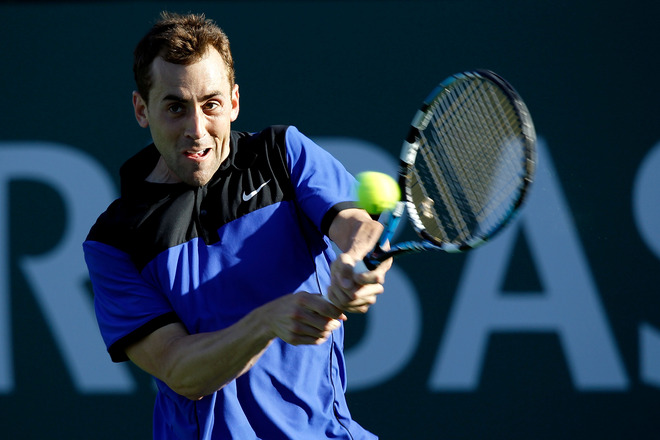By Charles Bricker
Watching a few moments of a thoroughly unremarkable qualifying match between Bobby Reynolds, that former Vanderbilt Commodore, and young German Christian Blocker, the current No. 2 at the University of Miami, really put me in a college tennis mood for the first time in a few years.
I was soon wondering if the foreign encroachment into U.S. university tennis had finally leveled off. I’m unhappy to report that it hasn’t, and, in fact, it appears the European/Asian/South American takeover over NCAA tennis is stronger than ever, prompting the rhetorical question: How can you be an All-American if you’re not an American at all?
Seven of the top 10 men and five of the top 10 women in NCAA Division I are foreigners and, if you project those numbers over the top 100. . .well, you don’t need me to do the math.

There’s nothing wrong with importing players from foreign soil. Reynolds, who played at Vandy from 2000 to 2003 and had only one foreign teammate, thinks it helps college tennis overall to have Americans competing against foreigners.
But if there are 70 percent foreign players in men’s NCAA tennis now, how much longer will it be before there are virtually no U.S. players to appreciate what these foreigners can do.
The issue of “just how many foreigners is enough” is not only philosophical, but economic. Vanderbilt and Miami are private schools. But tennis powerhouses like Virginia, Florida, Georgia and Texas are government supported schools and, while there’s nothing philosophically wrong with giving away U.S. tax dollars to, say, a Swede who wants to become a great heart surgeon, there is something a bit onerous about giving all these foreigners so much tax money merely because they’re good tennis players.
Of course nothing is likely to change on the issue of foreign balance in college tennis, and especially not in these depressed economic times. Jobs are scarce and no head tennis coach is going to put his employment at risk by refusing to give his limited number of scholarships to U.S. high schoolers who are inferior in ability to foreigners.
Maybe the right thing to do is to put a cap on foreign players — 50 percent seems the right figure. But the most influential people in college tennis have already gone around and around on this subject and it’s going nowhere. Ultimately, they throw out some vague argument about the constitutionality of limiting scholarships to Americans.
Reynolds’ view is that there would be significantly more Americans on college teams if they wouldn’t be in such a hurry to turn pro at 18.
“You see a lot of U.S. guys on tour because they feel they’re going to fall behind if they don’t turn pro,” said Reynolds after he had easily defeated Blocker 6-1, 6-1 at the BMW Challenger in Sunrise, Fla.
“So many guys who have gone to school have matured before turning pro, learned what it takes to be a pro. It’s the traveling and being on your own. Hitting the ball is the least of your worries on tour. Plus, you get a chance to play on a team, which is a great experience, if you go to college.
“If you’re dominating in college, you can always turn pro.”
Jesse Levine dominated in one year at the University of Florida and he’s now struggling to break top 100 on the ATP Tour. John Isner stayed four years at Georgia and he’s headed for stardom. But of course Isner is 6-foot-9 with a huge serve and Levine a little guy who has to work harder than most just to tread water. So maybe one formula doesn’t fit all.
Still, Reynolds doesn’t want to see any limits on foreigners playing college ball. “You should have the best competition you can have,” he said.
As for Reynolds’ own career, he got a full education at Vandy and, though he’s done merely OK in tennis, he hasn’t sniffed the heights. Yet after coming back from a long down period in 2009 because of a very serious wrist injury, he’s a happy puppy — even at No. 414. Certainly, that faded ranking will get better quickly as he works his way back into things.
He was training at home in Atlanta shortly before the 2009 French Open when the left wrist gave out (he’s a righty with a two-handed backhand).
He tried playing with a brace that didn’t allow his wrist to supine. He tried a one-handed backhand at Wimbledon. Neither was a success. Finally, he was fitted for a long, removable brace that covered his entire forearm and a bit of area above the elbow — a brace that left his arm at a 45-degree angle at the elbow.
“Being married, I was definitely sleeping alone for awhile,” he joked. “Three months, and then a month of rehab when it came off. But then, no pain.
Slowly, his game is coming around. He qualified at Indian Wells and was up a set and a break on Mario Ancic before losing in three. And when this journey is over, like a lot of foreigners educated in the U.S., he’ll have a college degree to fall back on.
Charles Bricker can be reached at nflwriterr@aol.com
